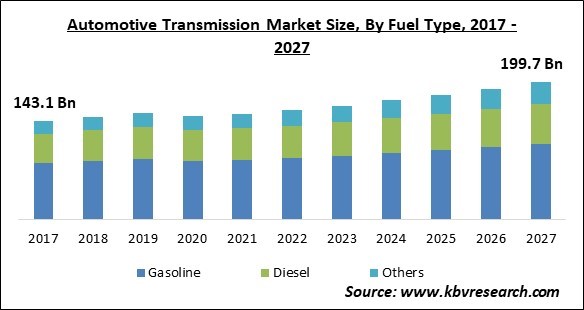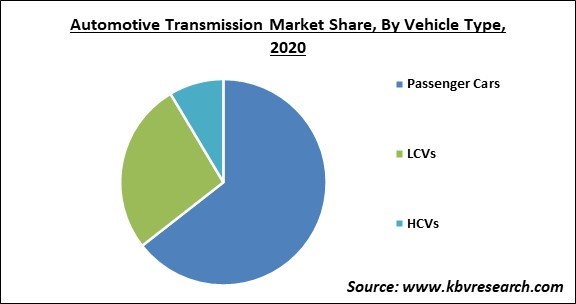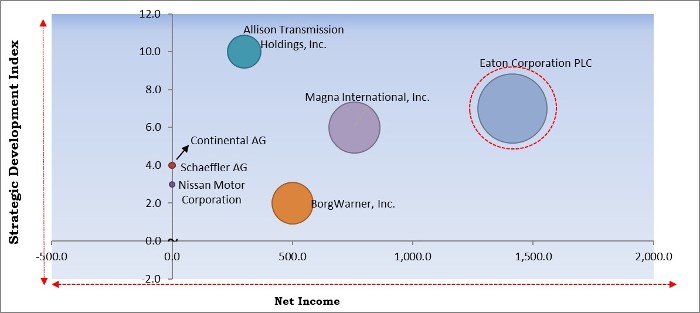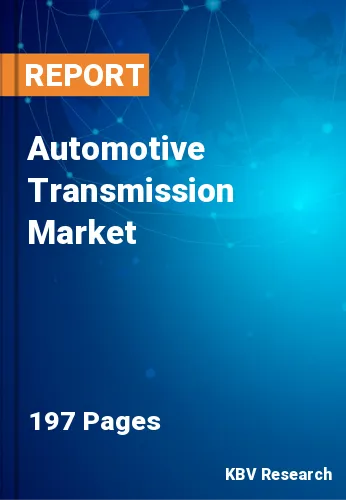The Global Automotive Transmission Market size is expected to reach $199.7 billion by 2027, rising at a market growth of 4.4% CAGR during the forecast period.
These days, motor vehicles are equipped with features that make driving more enjoyable, safe, and dependable for drivers. Manufacturers of automobiles are under pressure to create more sophisticated products with higher quality in shorter development cycles. Using traditional test-based development techniques to engineer the performance of mechanical designs is no longer an option.
In the last few years, car systems' technical characteristics and performance are greatly improved, and new technologies give increased safety and comfort while driving. Although drivers' perceptions and reflexes while driving continue to play an important part in traffic safety, but various new age vehicle technologies with their constant development is making safe vehicle motion that is less dependent on driver behaviour.
The key manufacturers of the industry are required to follow strict restrictions. For example, The National Highway Traffic Safety Administration (NHTSA) announced an agreement with the Association of International Automobile Manufacturers and the Alliance of Automobile Manufacturers in August 2006 under the Federal Motor Vehicle Safety Standards (FMVSS) to ensure that each and every vehicle with an automatic transmission produced in the United States is integrated with brake transmission system interlocks.

The outbreak of the COVID-19 pandemic has a negative impact on the automobile sector. The decline in the sales of the automotive vehicles during the pandemic owing to the imposition of various regulations like complete lockdown, disruption in supply chain and temporary shutdown of manufacturing units. Since people were locked inside their homes, the demand for personal vehicles has declined significantly.
On the other hand, during the recovery phase, companies are investing in various technical developments and the evolution of transmission systems across a variety of vehicle types, including heavy commercial vehicles (HCVs) and passenger cars. This would positively impact the growth of the market in the coming years.
The logistics business is being propelled forward by expanding urbanisation, industrialization, and increased transportation infrastructure. Furthermore, the expansion of commercial vehicles is aided by the evolution of the IT sector, the construction industry, the mining industry, and the ever-increasing population. There are two slants on the AMT, which enables drivers with better performance and reliability. Numerous commercial vehicle manufacturers are highly using AMT in their automobiles.
To improve fuel efficiency while maintaining safety and performance, modern automobiles require sophisticated materials. Lightweight materials have the ability to greatly enhance vehicle economy because it requires less energy to accelerate a lighter entity than a heavier one. In addition, lightweight automobile gearbox systems for production cars have been developed as a result of regulatory compliances on automakers and technological breakthroughs in automotive powertrains.
The automotive industry is shifting from traditional gasoline vehicles to electric automobiles all around the world. When compared to traditional fuels burning within IC engines, an electric vehicle does not require gears because the electric engine generates more force at zero RPM. The electric engine continuously produces an attracting field, which causes the engine to pivot when the electric vehicle's steering wheel moves. As a result, the grab system may not be required for the electric car.

Based on fuel type, the automotive transmission market is divided into Gasoline, Diesel and others. The diesel segment is expected to procure a significant share in automotive transmission market during the forecast period. Due to its high compression ratio, which allows for higher engine efficiency, diesel cars are witnessing a huge demand. A diesel engine is easier to maintain since it does not require an electrical system or spark plugs. This engine type is popular in automobiles and SUVs because it provides enhanced performance, similar to a gas engine, but with better gas mileage and reliability.
On the basis of transmission type, the automotive transmission is bifurcated into Manual and Automatic. The manual type segment dominated the market with the maximum revenue share in 2020 and is estimated to continue this trend over the forecast period. The cost of Manual is low than the automatic one, which is motivating manufacturers to use Manual in their products. Due to price sensitivity among population, consumers are more likely to choose manual transmission-based cars.
By vehicle type, the automotive transmission market is segmented into Passenger cars, LCVs and HCVs. The passenger cars segment garnered the maximum revenue share in the automotive transmission market in 2020 and is anticipated to continue this trend over the forecast period. The demand for passenger automobiles is influenced by volatile fuel prices and transit infrastructure. The improving economic outlook in the United States and many developing nations, such as China and India, is likely to boost the demand for passenger automobiles in the world.
| Report Attribute | Details |
|---|---|
| Market size value in 2020 | USD 151.3 Billion |
| Market size forecast in 2027 | USD 199.7 Billion |
| Base Year | 2020 |
| Historical Period | 2017 to 2019 |
| Forecast Period | 2021 to 2027 |
| Revenue Growth Rate | CAGR of 4.4% from 2021 to 2027 |
| Number of Pages | 197 |
| Number of Tables | 342 |
| Report coverage | Market Trends, Revenue Estimation and Forecast, Segmentation Analysis, Regional and Country Breakdown, Competitive Landscape, Companies Strategic Developments, Company Profiling |
| Segments covered | Fuel Type, Transmission Type, Vehicle Type, Region |
| Country scope | US, Canada, Mexico, Germany, UK, France, Russia, Spain, Italy, China, Japan, India, South Korea, Singapore, Malaysia, Brazil, Argentina, UAE, Saudi Arabia, South Africa, Nigeria |
| Growth Drivers |
|
| Restraints |
|
Region-wise, the automotive transmission market is analyzed across North America, Europe, Asia Pacific and LAMEA. The Asia Pacific region emerged as the leading region in the automotive transmission market with the highest revenue share in 2020 and projected to maintain its dominance over the forecast period. Companies in Asia Pacific have been encouraged to adopt efficient transmission systems by stringent regulations. Furthermore, rising vehicle sales, particularly in countries such as China, India, Japan, and South Korea, along with the presence of key market players are expected to spur the growth of regional market during the forecast period.
Free Valuable Insights: Global Automotive Transmission Market size to reach USD 199.7 Billion by 2027

The major strategies followed by the market participants are Acquisitions. Based on the Analysis presented in the Cardinal matrix; Eaton Corporation PLC is the major forerunner in the Automotive Transmission Market. Companies such as Allison Transmission Holdings, Inc., BorgWarner, Inc., Magna International, Inc. are some of the key innovators in the Market.
The market research report covers the analysis of key stake holders of the market. Key companies profiled in the report include Nissan Motor Corporation (Jatco Ltd), Allison Transmission Holdings, Inc., GKN plc (Melrose Industries plc), Continental AG, Eaton Corporation PLC, BorgWarner, Inc., Magna International, Inc., ZF Friedrichshafen AG, and Schaeffler AG.
By Fuel Type
By Transmission Type
By Vehicle Type
By Geography
The global automotive transmission market size is expected to reach $199.7 billion by 2027.
Increase in the utilization of lightweight transmission systems of the companies are driving the market in coming years, however, Surging adoption of electric vehicles have limited the growth of the market.
Nissan Motor Corporation (Jatco Ltd), Allison Transmission Holdings, Inc., GKN plc (Melrose Industries plc), Continental AG, Eaton Corporation PLC, BorgWarner, Inc., Magna International, Inc., ZF Friedrichshafen AG, and Schaeffler AG.
The Gasoline market acquired maximum revenue share in the Global Automotive Transmission Market by Fuel Type 2020, and would continue to be a dominant market till 2027.
The HCVs market would showcase highest growth rate of 6.9% during (2021 - 2027). HCV sales have been boosted by increased industry and infrastructure-building activities.
The Asia Pacific market region is leading in the Global Automotive Transmission Market by Region 2020, and would continue to be a dominant market till 2027.
Our team of dedicated experts can provide you with attractive expansion opportunities for your business.

